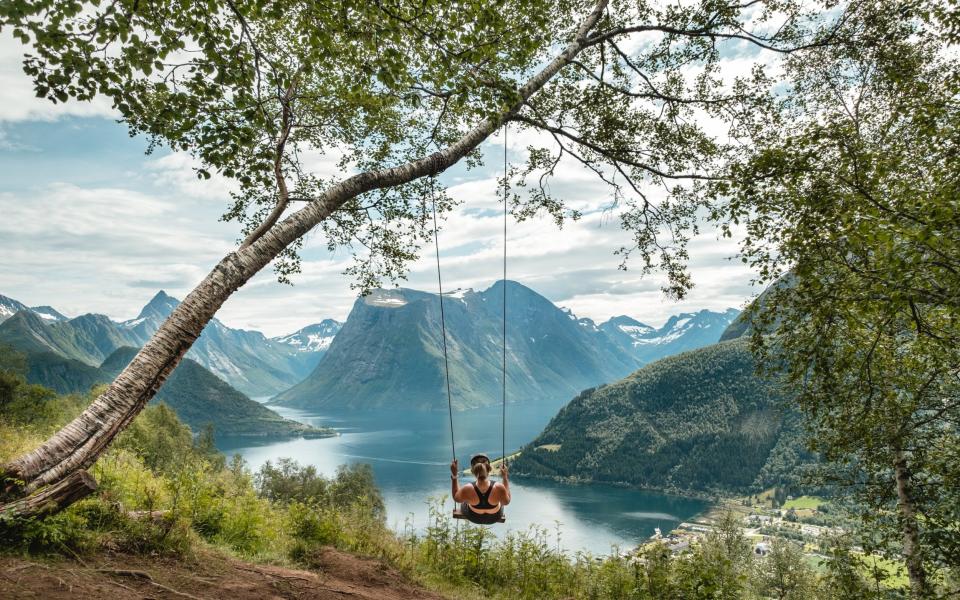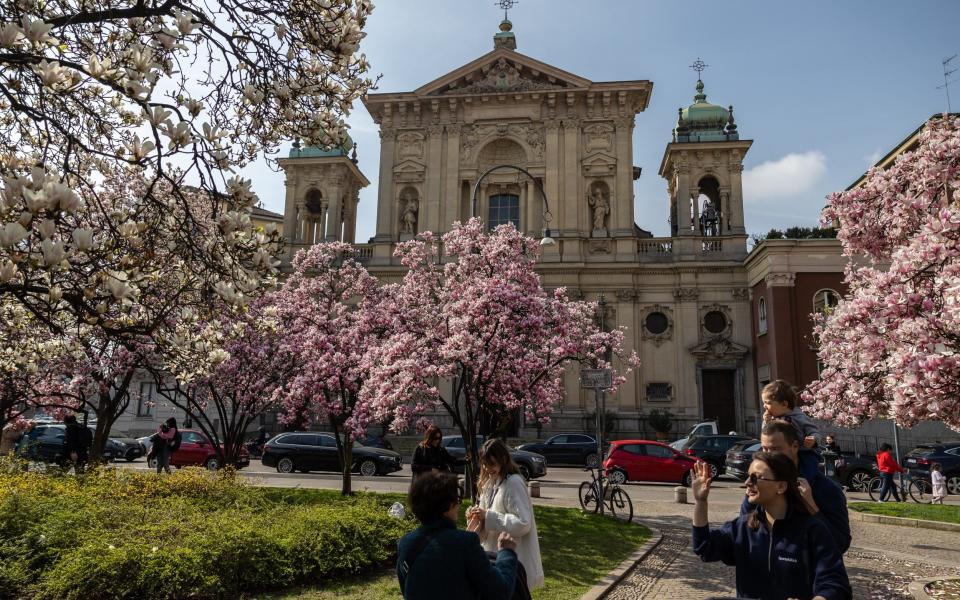It is said that climate change is mainly experienced through online videos – until you are the one filming the segment. And it increasingly feels like vacationers are the people holding the phones.
Take 2023, when forest fires – first in Spain, then Italy and then Greece – devastated the countryside, turning villages into hell and devastating local communities. They also caused many holidaymakers to turn to tour operators to help them evacuate.
It seems inevitable that our vacations will change in the coming decades as our weather continues to change. People are already exploring more sustainable ways to see the world, for example by taking fewer trips, using better modes of transportation or checking into local accommodations.


But these highly publicized events, coupled with the desire to avoid extreme heat or unpredictable weather, can also influence the types of trips vacationers take. By 2050, we could explore new locations, change our travel season or admire slightly changed views – whether of the city skyline or the great blue expanse of the sea.
Below are seven ways holidays could have changed by 2050.
Your summer holiday can be in Northern Europe (or not in summer at all)
The traditional two-week holiday of the past, in a resort in France or Spain, is already starting to feel uncomfortably warm for some. According to the European Environment Agency, the continent is warming faster than the global average; Extreme heat waves are expected to become much more common. For tourists looking for a soft glow instead of sunburn, the holiday card is being redrawn.
Northern Europe, unlike the Mediterranean, could become the favorite destination in summer. Temperatures in Norway in July are between 25 and 30 degrees, with plenty of extra sunlight, making more hours available for outdoor activities.
Tour operator Black Tomato has seen an increase in demand from travelers looking to travel to cooler climates, “particularly in July and August,” according to head of product Carolyn Addison. The number of bookings in Scandinavia has increased by 175 percent this summer compared to last summer, with Norway proving to be particularly popular.


The local population is taking up the challenge. New hotel openings, including Sommero in Oslo, add cool to already booming cities; the little-known beaches of the Baltics provide a tranquil alternative to the typically teeming Mediterranean resorts. And it is sensible that the Nordic countries are keen to develop their green reputation while welcoming more visitors.
However, if the Costa del Sol is non-negotiable, travel times may have to change. James Thornton, CEO of Intrepid Travel, has noted that our holiday seasons are already changing, with the company reporting an 88 percent increase in European bookings for April and May this year. The “shoulder season,” as it is known, will become the normal time to travel for many. In addition to the lower temperatures, traveling in May or September remains cheaper, at least for the time being.
Those villas over the water can be flooded
The Maldives are the poster destination for honeymooners. It is also an example of the most direct consequences of climate change. This low-lying island network is so threatened by any sea level rise that the government has made the issue a priority and is spending almost half of the national budget on mitigation measures. This is certainly necessary: the World Bank estimates that 80 percent of the country will be completely underwater by 2050.


So it is a matter of survival for hotels and resorts to invest in eco-friendly practices. Places like the Barefoot Eco Hotel are keen to highlight their positive impact. In addition to guest-focused initiatives such as ‘responsible snorkeling’, they monitor local marine life in partnership with an underwater charity and source only sustainably grown materials.
Whether the hospitality industry can bring benefits to the islands beyond their economic impact remains to be seen. Either way, visitors in the near future will see many of the islands surrounded by sea walls (something that is already the case in the capital Malé).
City trips are getting hotter, but also greener
It will be cities that will suffer most from the higher temperatures. They act as ‘heat islands’, sometimes up to 10-15 degrees warmer than the rural areas surrounding them. If you usually march through a metropolis during your vacation, you can feel the heat.


Fortunately, there are relatively simple ways to cool down cities. A groundbreaking tree-planting program in Lisbon cost the city $1.9 million, but delivered an estimated $8.4 million in benefits: it provided shade, reflected sunlight and saved energy.
Milan has followed suit, pledging to plant three million trees by 2030; In Basel, government officials have gone one step further by creating flower meadows on every flat roof in the city. By 2050, these types of plans could allow city residents and tourists to avoid the worst of the heat while enjoying greener cityscapes.
We will cherish the underwater world
Across the world, new nature patterns are influencing the way we encounter local species. Underwater, the planet could lose up to 90 percent of its coral reefs (which act as a natural flood barrier for low-lying islands like the Maldives) if global temperatures rise by 1.5 degrees.
By 2050, it may be harder to find marine life. Diving companies are already warning diving enthusiasts about the bleached reefs. Phil North of Dive Worldwide says that “in certain areas we have to explain to customers that shallow corals are showing some bleaching. It is part of our responsibility to advise customers on what to expect during their holiday, with the same care and dedication that we put into the arrangements ourselves.”
There is also growing awareness among the diving community about simple things they can do to protect underwater species: wear only reef-safe sunscreen, take care not to touch or disturb the reef and book at one of PADI’s Eco Centers, resorts and locations that showed their commitment to conservation. This could hopefully be the norm by 2050.
Travel insurance can become more expensive
Last year, Rhodes and Corfu were victims of particularly devastating forest fires; airlines and local emergency services rushed to rescue thousands of British tourists. It’s a terrifying prospect that holidaymakers will continue to face.
As global temperatures rise, so do the dry, tinderbox conditions that make forest fires more likely – on European islands these can be exacerbated by warm breezes and vegetation. This means that travelers must be prepared: insurer Staysure advises to keep the contact details of the person you book with at hand during a trip. It’s also worth checking the documents to make sure your policy includes cover for trip interruptions or natural disasters.
As travel insurers pay out more and more for problems caused by extreme weather conditions, premium prices will inevitably rise as well. In recently published research, Alvaro Iturmendi, travel insurance expert at Confused.com, suggested that consumers are already buying more comprehensive policies, while the market is less competitive due to a dip in the number of people going on holiday after the pandemic.
Britain could take the lead in wine tourism
The vineyards of southern England – once ridiculed – are now flourishing. The warmer temperatures produce much-praised, refreshing bottles and pave the way for the development of wine tourism.


It’s not just in the south either. Ryedale Vineyards is one of Britain’s most northerly vineyards, located in North Yorkshire: visitors can spend a day visiting the vines and tasting the product. Back in the heart of the North Downs at Denbies, footpaths wind through the vineyards and back to a boutique hotel. It reflects a promising form of homegrown hospitality that promises more in the future.
Ski resorts will also be summer resorts
The amount of snowfall in ski-friendly destinations is always a cause for conversation, as shown in our weekly reports. However, its unpredictability in the face of climate change means that many enterprising resorts are also turning to summer travelers.
Take Whistler in Canada: a snow-sure place in winter, but now also a good place for a summer holiday. The routes include paddleboarding and exploring farmers’ markets, taking advantage of the exceptional scenery while not, crucially, relying on snow. French resorts are following suit, especially as the white stuff becomes less certain. Chamonix now sees many more visitors in summer than in winter.
The changes mark a significant shift from the strictly seasonal business model, instead opening up Alpine towns to hikers, cyclists and mountain climbers all year round. And with the trend towards active holidays strengthening as the heat increases, many more people may be planning a summer getaway to the mountains.